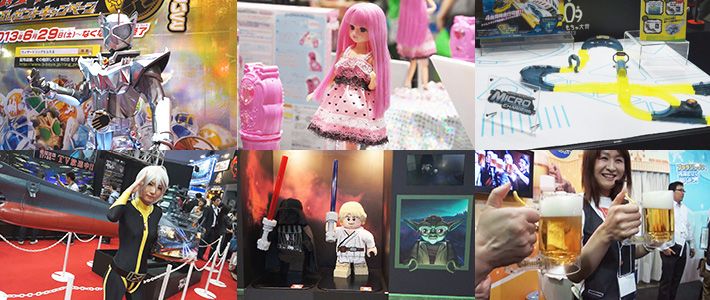
Not Just for Kids: The 2013 International Tokyo Toy Show
Guideto Japan
Culture- English
- 日本語
- 简体字
- 繁體字
- Français
- Español
- العربية
- Русский
In June 2013 the International Tokyo Toy Show was held at Tokyo Big Sight in the city’s Odaiba area. Participating in the event were 148 toymakers from Japan and other countries around the world, displaying around 35,000 products in total. More than 140,000 people, including families and toy fanatics, visited on the two days open to the general public.
Japanese Toys for the Kid at Heart
According to Tsuda Hiroshi, director of the Japan Toy Association, which hosted the event, Japanese toys have four basic characteristics.
First, there is a strong tendency in Japan for toys to be modeled after things popular among adults. One example of this is the toys related to the Tokyo Skytree tower, which opened in 2012, and in 2013 there have been many toys designed along the lines of a tablet computer.
 Computer tablet toys that can connect to the Internet are a recent trend, like the “tap me” product from MegaHouse (left), while smartphone toys remain popular (right).
Computer tablet toys that can connect to the Internet are a recent trend, like the “tap me” product from MegaHouse (left), while smartphone toys remain popular (right).
The second characteristic is the cutting-edge technology featured in many Japanese toys.
 The fingernail-size figurines in the Minimal Zoo Jare Inu series (left; photograph courtesy of Tomy), and the Micro Chargers series of 20mm racing cars whose batteries can be charged in just 8 seconds (right; photograph courtesy of Happinet).
The fingernail-size figurines in the Minimal Zoo Jare Inu series (left; photograph courtesy of Tomy), and the Micro Chargers series of 20mm racing cars whose batteries can be charged in just 8 seconds (right; photograph courtesy of Happinet).
The third characteristic is the large amount of blocks and puzzles among Japanese toys. These often consist of challenging games that test the wits of not only kids but adults as well—and they are also used as items for home decorating.
 The world’s tiniest building blocks are the nanoblocks of Kawada Co., Ltd., just 4mm × 4mm. The brand’s lineup includes characters like Hello Kitty (right). The Lego collection also features famous faces (left).
The world’s tiniest building blocks are the nanoblocks of Kawada Co., Ltd., just 4mm × 4mm. The brand’s lineup includes characters like Hello Kitty (right). The Lego collection also features famous faces (left).
Familiar Faces from the Character World
And the fourth characteristic is an emphasis on character-related toys. Toys featuring characters from TV programs and the like continue to be popular in Japan.
 The Licca-chan dolls have been a hit among Japanese girls for nearly half a century since their launch in 1967 (photograph courtesy of Tomy). Meanwhile, Kamen Rider Wizard has remained a favorite hero of boys (photograph courtesy of Bandai).
The Licca-chan dolls have been a hit among Japanese girls for nearly half a century since their launch in 1967 (photograph courtesy of Tomy). Meanwhile, Kamen Rider Wizard has remained a favorite hero of boys (photograph courtesy of Bandai).
Because Japanese toys have these four characteristics, Tsuda notes, they can also appeal to adults. Japan’s low birthrate means fewer kids, so toymakers need to come up with products that can appeal to people across generational lines.
(Original Japanese article by Yanagisawa Miho.)